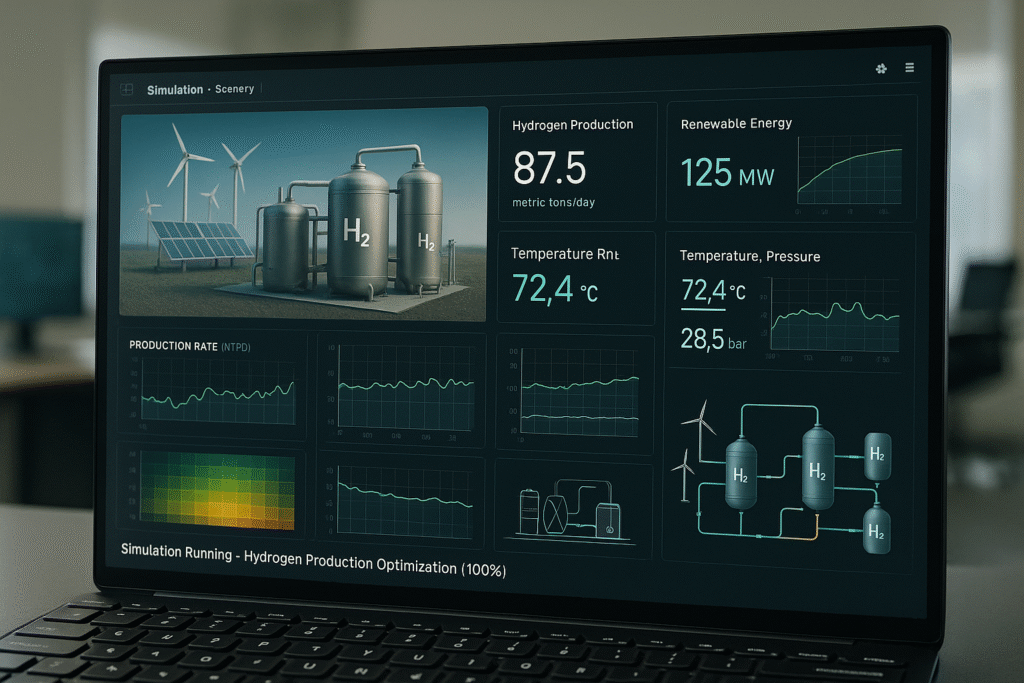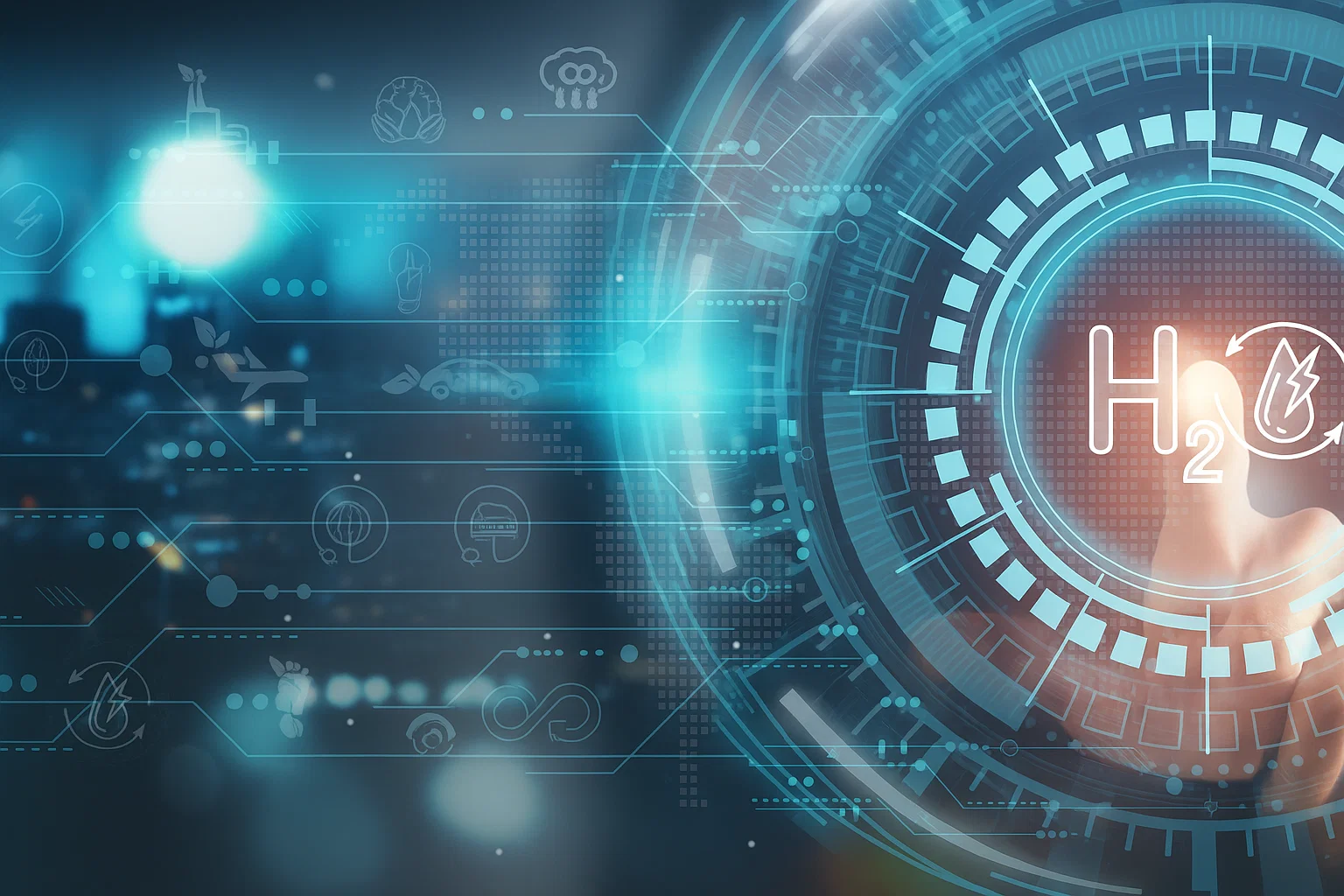The global race for decarbonization is profoundly transforming the energy sector. Among the most promising solutions to enable this transition, green hydrogen stands out, not only as a clean alternative but also as a strategic driver for countries seeking sustainable energy autonomy. However, the advancement of this technology depends on sophisticated analyses, and this is precisely where computational models come into their own.
Producing green hydrogen economically is a multifaceted challenge. Water electrolysis with renewable energy involves a series of variables, from the intermittency of wind and solar sources to the balance between initial investment and operating costs. Companies and governments around the world are pouring billions into this sector, but commercial success depends, above all, on the ability to simulate, predict, and optimize each link in the production chain. This article explores how computational modeling is redefining the planning and operation of green hydrogen plants, based on studies, real-world applications, and emerging trends.
Mathematical optimization as a strategic pillar
Planning a green hydrogen plant requires critical decisions: how much capacity to install? How to scale storage? Which operational strategy offers the best return given the variability of renewable sources? To answer these questions, researchers have been developing optimization models based on advanced mathematics.
A striking example comes from the State University of Campinas, with the X-DRO (Extreme Distributionally Robust Optimization) model. This approach combines mathematical techniques that simultaneously reduce investment and operating costs, ensuring reliable performance even in the face of volatile renewable sources. Its unique feature lies in its ability to integrate discrete variables, such as the number of devices required, and continuous variables, such as energy volumes and operating costs.
The strategic importance of this methodology is clear. In a market where profit margins are tight and competitiveness depends on operational efficiency, tools capable of reducing uncertainty and optimizing resources become concrete advantages. Companies that master this type of modeling can reduce production costs by up to 15%, a difference that can determine the financial viability of a project.

CFD Simulation: Understanding the Physics of Equipment
In addition to system optimization, understanding the physical and chemical phenomena within the equipment is essential. Computational fluid dynamics (CFD) allows for precise three-dimensional simulation of the internal behavior of hydrogen production cells, analyzing electrical current distribution, mass and heat transfer, and electrochemical reactions.
Software like ANSYS Fluent and COMSOL Multiphysics has become standard in research centers worldwide. Recent studies have applied CFD to optimize the channel shape of PEM (Proton Exchange Membrane) cells, identifying configurations that increase energy efficiency by up to 8%. In an industry where each percentage point of efficiency represents millions in operational savings, such gains have a direct impact on competitiveness.
The COMSOL platform, through its Fuel Cell & Electrolyzer module, offers integrated capabilities for simulating not only PEM cells but also other production technologies. This versatility allows developers to compare different options and choose the most suitable for specific operating conditions, a crucial aspect in a technology market still consolidating.
Artificial Intelligence and Digital Twins: The Next Frontier
The convergence of artificial intelligence and computational modeling is creating new possibilities. Digital twins, virtual replicas of physical systems updated in real time, enable continuous optimization based on operational data. Combined with machine learning algorithms, these systems identify performance patterns and automatically adjust operational parameters.
Brazilian studies are already demonstrating practical applications. AI systems integrated with weather forecasts adjust equipment consumption in real time, maximizing the use of renewable energy when it is abundant and reducing operations during periods of scarcity. Platforms like CibusCell use big data analysis to optimize energy consumption based on market prices, reporting reductions of up to 30% in electricity costs.
Deep Reinforcement Learning algorithms represent another promising frontier. Unlike static optimizations, DRL allows systems to learn optimal operational strategies through continuous interaction with sensor data, adapting to changing conditions without human intervention. For large plant operators, this optimization autonomy can represent a substantial competitive advantage.
Technoeconomic analysis: Translating technology into viability
Computer models are also essential for technoeconomic analysis (TEA), which assesses the financial viability of projects. Methodologies developed by institutions such as the CSIRO integrate process simulation, mass and energy balances, equipment sizing, and cash flow analysis.
The methodology known as Levelized Cost of Hydrogen (LCOH) has become a standard for comparing projects. Brazilian studies applied LCOH to hypothetical 100-megawatt plants, considering different renewable energy price and equipment cost scenarios. The results indicate that, under favorable conditions, Brazil can produce green hydrogen at costs competitive with traditional natural gas-based routes by 2030.
This ability to simulate diverse economic scenarios is crucial for managers and investors. Green hydrogen plant projects often involve billions of dollars in capital expenditures, and tools that increase the accuracy of financial projections reduce risk and facilitate fundraising.
Competitive advantages and emerging projects in the Brazilian context
Brazil has unique conditions to position itself as a leading player in the green hydrogen economy. With an electricity matrix comprised of approximately 90% renewable sources and ample hydroelectric storage capacity, the country offers unparalleled operational flexibility. Research by the National Council for the Environment (CNPEM) shows that, even considering the emissions associated with infrastructure construction, Brazilian green hydrogen would emit approximately 1 kg of CO₂ equivalent per kg produced, compared to 11 kg with the traditional process.
Several national projects already utilize computational modeling extensively. The pilot unit in Ceará, with a capacity of 22.5 kg per hour, uses simulations to optimize the integration of photovoltaic energy and hydrogen production. Larger-scale projects, such as Atlas Agro, which plans an investment of R$4.3 billion for 2.5 gigawatts of capacity, rely heavily on computational modeling for feasibility analysis and operational planning.
Challenges and future perspectives
Despite the progress, significant challenges remain. Limitations in the quality and availability of real-time data, a lack of standardization across platforms, and high computational processing demands are significant barriers. Integration between different modeling systems and the development of more transparent and interpretable models, essential for building investor confidence, are among the industry's priorities.
Emerging trends point to hybrid methodologies that combine artificial intelligence and quantum computing, intelligent supply chain management, and leaner models geared toward industrial applications. The convergence of high-performance computing, the Internet of Things, and predictive analytics promises to transform not only production but the entire green hydrogen value chain.
Conclusion
Computational models have gone from being support tools to central pieces in building the green hydrogen economy. From mathematical optimization to artificial intelligence-powered digital twins, these technologies accelerate commercialization and measurably reduce costs. For companies and governments committed to the energy transition, investing in computational modeling capabilities is no longer an option. It's a strategic imperative to ensure competitiveness in the 21st century.

